danbricklin.com/log
|
|
|
|
My take on SymTrend: A way to track medical symptoms using a PDA or a web browser
|
Disclaimer: I have a financial and personal relationship with this company (as I explain at the end of this essay). I am not a medical professional in any sense of the term and this is not medical advice. What follows are my observations in hope that they may be helpful to others.
What is SymTrend and what is the need that it fills?
I asked SymTrend co-founder Dr. Calvanio how he would introduce SymTrend. Here is what he suggested:
Someone asks, "How are things going?" That someone is a physician, a psychologist, a special-Ed teacher, a personal coach, an alternative medicine practitioner, etc. The question is an invitation for you to report the progress you have made toward feeling better and functioning better using a prescribed treatment or jointly designed program. Sometimes the progress report is quick and easy to make, "Look, the rash is gone." Far more often than we currently recognize, reporting the required information is neither easy, accurate, nor complete. These impediments to progress occur for a host of reasons and SymTrend addresses each one.
SymTrend is an electronic diary system that is designed to optimize symptom and behavior reporting, progress tracking, and session to session progress. It combines tracking tools to see how things are going, with analytic tools for seeing what might subvert or retard treatment efficacy. It also contains guidance tools that can help make things go better. SymTrend is most useful when one or more of the following occur in a health or educational challenge:
If you or someone you know has a condition that could be helped by SymTrend tracking, analytics, or reminder support, you should let them know about SymTrend (www.symtrend.com). They can see if it is an appropriate addition to their treatment. SymTrend has just become generally available so it is unlikely that they have already evaluated it. As of this writing, SymTrend has already been customized for ADHD, anxiety, Asperger's syndrome, autism, cancer treatment, depression and bipolar disorder, postpartum or menopausal issues, stress, headache, and neurological conditions such as epilepsy, brain injury, and Parkinson's disease.
Sample screens and output
Here is an example of what using the system looks like. These images come from the samples on the SymTrend website -- read the case histories there for more examples and a detailed explanation. The actual questions and data collected vary depending upon the condition being treated.
The input is done either on a handheld PDA or a web-based form. You track symptoms by filling in a series of forms that look like this (simulated PDA screen):
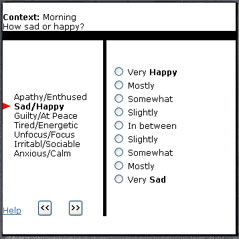 And this:
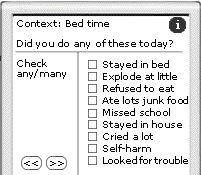 Once you have a few weeks of data, you can look at reports that look like this (available on a website):
A day-to-day tracking report:
Two indices, sadness and anxiety are charted
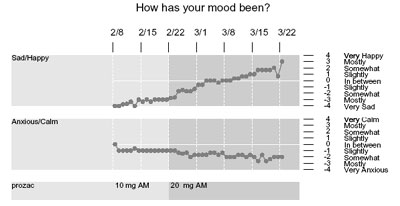 The positive impact of Prozac at 20 mg is evident in the Sad/Happy rating, but the medication caused an increase in anxiety for this individual
A Summary Report:
Two Periods, pre- and post-medication,
are compared in seven indices
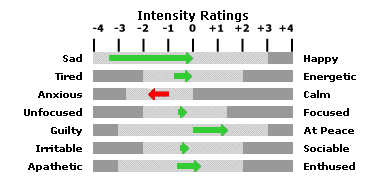 The tip of the arrow is the average post medication value. The tail is the corresponding pre-value. The size of the arrow represents the amount of change. A green arrow pointing rightward is positive change; red arrow pointing leftward is negative change. The light gray background indicates the score range (in essence each row is a visual t-test).
An Analytic Report:
Looking for warning signs
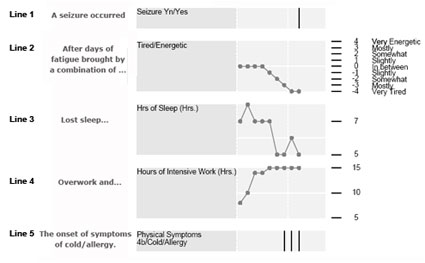 A potential warning sign relationship between a seizure's occurrence (line 1) and increased fatigue (line 2), resulting from cumulative stress: excessive work (line 4), loss of sleep (line 3), and cold/allergy symptoms (line 5).
(Note: The preceding data were created for illustrative purposes.)
The value of such detail
Many conditions such as depression, anxiety, fatigue, pain, concentration, behavior problems, can be influenced by events called "contributing factors". SymTrend helps do the detective work to identify these contributing factors. They are not always what you think, especially when two different straws are needed to break the camel's back. Knowing the contributing factor "mine fields" can guide constructive problem solving to avoid them or mute their impact. Minor changes in symptoms can have important quality of life effects for both the patient and others in their lives. Understanding the impact a treatment is having helps us know whether it is worth continuing. Subtle, gradual changes may not be obvious enough to give you the encouragement needed unless presented in a graphic manner. As I see it, healthcare professionals are usually more concerned with gross changes that have easily measurable health effects, and their remuneration and scheduling constraints do not afford them the time to follow the patient themselves on a daily basis to do fine tuning. SymTrend gives the patient, perhaps along with their healthcare provider, another tool to help understand how contributing factors effect progress. This information can be used by the patient and/or provider (as appropriate) to try to optimize treatment.
Why use SymTrend instead of doing it yourself with paper or computer?
People have used paper diaries for many years to track symptoms and a simple chart is easy to create with common tools like a spreadsheet. What makes SymTrend special is the full combination of things that it does. There is a lot to this system and each of the parts can make a difference to the final outcome.
The indices you may want to check will depend on the diagnosis, a variant of the diagnosis, gender, and race. SymTrend has grouped these indices together into specific report diaries called Health Logs.
The SymTrend company can be commissioned to create custom Health Logs for specific needs, combined illnesses, and changing conditions over time. For example, psychoactive drugs have separate effects on the axes of tired/energetic, happy/sad, anxious/calm, etc., and these should be measured separately. There is a benefit from using a professionally created log that may include things you would not have thought to track but that may prove to be important.
To track symptoms throughout the day SymTrend has a PDA version (for the Palm OS) that signals an alarm at the appropriate times to remind you to fill in the data or take some action. If you want, they also have a web-based version and reminders can be sent as emails. The inputs from both end up on a server they maintain. In some cases it is designed for the data to be entered by the patient and in other cases by the caregiver or a teacher.
The act of filling in the data can make the patient more aware of certain symptoms and can actually be part of the treatment itself. The reminders can keep them "front and center" so they don't get forgotten. In addition, when used on a handheld computer, the application can provide strategies for handling day-to-day situations. It can remind the individual about appropriate ways to interact, how to handle stressful situations, to change negative thoughts or to perform the steps of a task in the correct order. Research projects are currently underway with teens with Asperger's syndrome and anxiety disorders that provide that type of guidance. This use and some of the research is covered in an article by Peter Schworm that ran in the April 25, 2006 Boston Globe's South section titled "For autistic students, social skills from a handheld device".
SymTrend includes special statistical software to create the charts that help present the data. Calculating trends from the jumble of real-life data of a single individual is a special type of statistical analysis. Those charts can be printed out to bring to healthcare professionals.
As I have been told, the system is maintained in a HIPAA-compliant way (the website is served using HTTPS, the servers are in special locked cages, etc.). They have privacy controls that let you optionally share the data with your healthcare professional online.
The cost for personal use is pretty low (on the order of a few office visit co-payments): $75 for a three-month subscription or $195 for a year (the optional PDA is extra -- you buy your own). There are reasons to believe that people are more motivated to keep using something like this for the full period necessary for best results when there is some money involved. Licensed professionals can create an account for free that lets them follow the progress of the patients/clients/students who give them permission. Compared to the costs involved in the treatment of most of the conditions SymTrend deals with, the subscription fees and even the PDA cost are pretty minor.
Why I got interested in SymTrend
My association with SymTrend goes back a long time. I've known SymTrend's principals, Dr.'s Ron Calvanio and Minna Levine, for a long time - I met Ron a few years before I came up with VisiCalc. They both have watched me go through the development of my products and companies. They are both quite smart, good people, and are close friends of mine.
Ron (SymTrend's co-founder and chief scientific officer for adults) was Director of Neuropsychology at Spaulding Rehabilitation Hospital (a Partners Healthcare System hospital along with Massachusetts General Hospital), one of the largest rehabilitation hospitals in United States. He worked there with many brain injured patients. He is an instructor, Department of Neurology, at Harvard Medical School. At one point I brought Ron in as a consultant to Trellix to help us make some choices that involved learning what was known about various perceptual issues. Minna (SymTrend's other co-founder and president) has been involved in information system development for healthcare and academia as well as market research on the statistical side. She has led the transformation of Ron's prototype into the complete system they have today.
Back in 1998, Ron told me about some research he was doing on a type of assistive product. As implemented at the time, it was for doing measurement to aid in determining dosages of psychoactive drugs for treatment of patients with brain injuries (an area where he was an active clinician). Also at that time, Ron was kind enough to act as an advisor to my family to help us understand issues with my father who had sustained a severe brain injury in a car accident a few years earlier. My father was quite impaired and required assistance for most tasks. Suffering from a frontal lobe injury, his affect and motivation were quite compromised. Ron felt that there were some drugs that might help him, and started working with other healthcare professionals who were qualified to prescribe them.
A major question in a situation like this was monitoring exactly what effect the drug or drugs were having. My father's memory and self-awareness was quite impaired, so asking him if he was feeling better this week than last was not a reasonable possibility. The drugs we were considering had a variety of effects, including attentiveness, mood, tiredness, agitation, etc. Ron thought that my father would be a good test for this use of a PDA for recording my father's self-reported ratings of feelings on various scales throughout the day. Also, the constant requirement to respond to a beeping device in his pocket might help keep him more in the "here and now".
As a family, we decided to try this experimental system. Every hour my father would take out the beeping Psion (the PDA they were using at the time -- it now runs on the Palm OS instead) and push buttons on the keyboard to rate his feelings on various scales. "Somewhat Pessimistic, Somewhat Optimistic, Optimistic, Very Optimistic", would pop up on the screen and he'd choose an answer. His answers seemed pretty monotonous and meaningless as we'd watch him fill it out day after day. He responded well to the device, though, and we continued on. When Ron processed the saved data and produced reports, though, there were clear patterns during the day and during the week. When different drug combinations were tried, changes showed up. Even in my father's severely compromised state there was useful data. Subtle changes were trackable. His variability throughout the day was clear and the drugs being prescribed had effects that varied over time so measuring things to the hour gave us comfort.
I also saw the contrast with the normal style of prescribing. A weekly, semiweekly, or monthly visit to a prescribing professional with a 20- or 45-minute window into the person's life is not enough time. When on one occasion my mother and father disagreed about my father's functioning, a SymTrend chart provided a clarifying view for treatment decision making. I saw the value of Ron's idea.
Once we set the dosing, my father eventually stopped using the system (it was an early prototype and at the time there was no money to support it), and over the years his condition has deteriorated in various ways. His use is not germane to the current system except in how it showed me first hand the value families and healthcare providers might find in such a system. I saw the value of actually collecting data and processing it to look for statistical trends that may not be apparent to someone living day-to-day with those symptoms. As one who sees the value in using computers as tools to help us, I can't imagine not having such a system available to those that might want it.
When Ron and Minna decided to devote their lives to bringing this style of assistance to general use, I encouraged them and have been advising them from a general computer and business viewpoint ever since.
Now that SymTrend is finally available publicly in a form that Minna and Ron feel is acceptable to a wide audience (and not just carefully controlled studies), they have given me the go ahead to discuss it more widely on my blog and in other public forums than I have in the past. I hope my posting here will end up helping people who otherwise would miss out on knowing about this tool.
-Dan Bricklin, April 30, 2006
Here's a YouTube video that shows use of SymTrend for Asperger Syndrome:
-Dan Bricklin, November 29, 2007
|
|
|
© Copyright 1999-2018 by Daniel Bricklin
All Rights Reserved.
See disclaimer on home page.
|